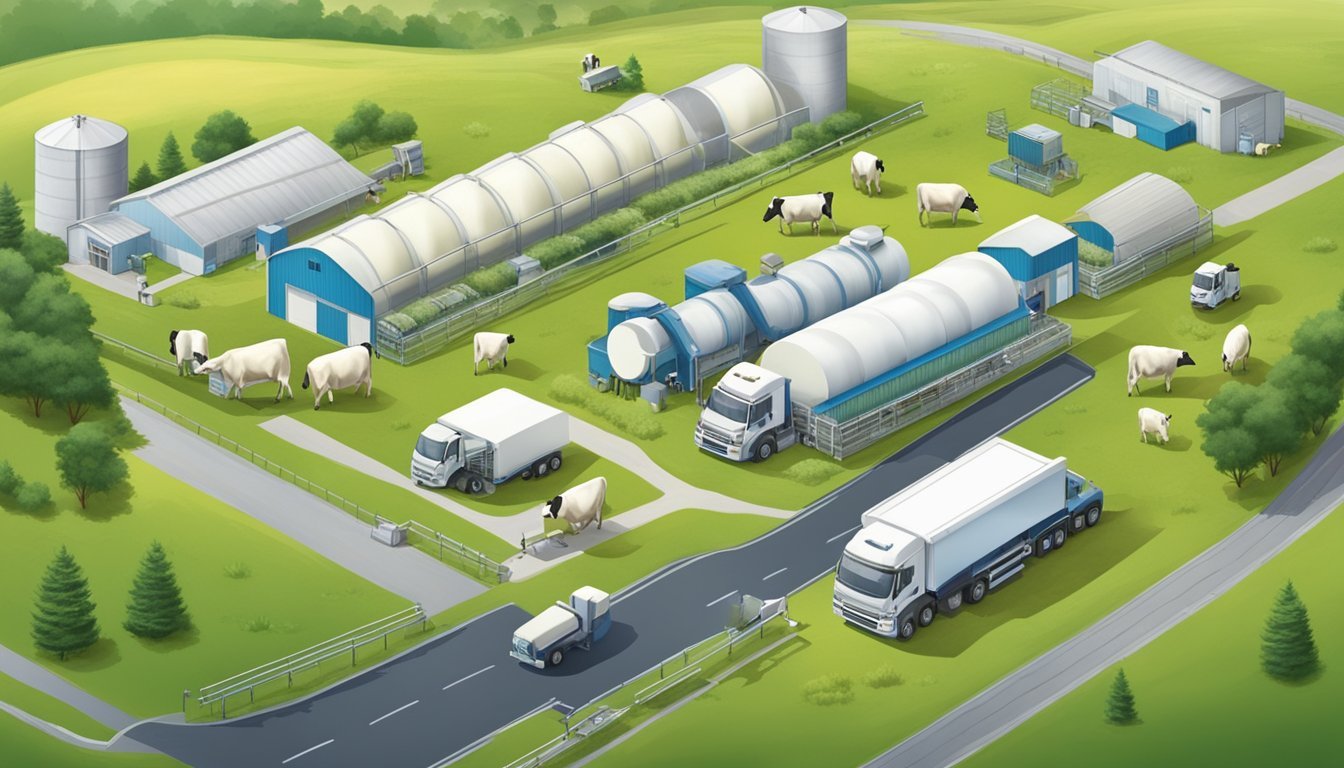The Business of Raw Milk
Ensuring Safe and Legal Practices in Production and Sales
The dairy industry stands at a crossroads with the burgeoning interest in raw milk—an unprocessed product straight from the cow. Sales of raw milk have the potential to offer US family dairy farms a new business opportunity, especially at a time when many are seeking sustainable avenues to remain profitable in the face of increasing competition and market pressure. Legalization efforts in several states have ignited discussions on the role raw milk could play in reinvigorating small-scale dairy operations, delivering a more direct farm-to-table experience for consumers eager for natural and less processed foods.
Navigating the production and sales of raw milk presents unique challenges. Farmers must adhere to rigorous standards to ensure the product remains low-risk for consumers, requiring specialized production practices. The risks associated with raw milk, which include the potential for harboring pathogens, underscore the importance of stringent safety measures and monitoring. Despite these hurdles, the growing demand for raw milk indicates a shift in consumer preferences towards products perceived as more wholesome and indicative of clean eating trends.
The growth trajectory for raw milk sales suggests a promising avenue for dairy farms, yet the sector must balance opportunity with responsibility. The success of transitioning toward raw milk sales hinges on farmers' ability to implement necessary safety protocols and education aimed at protecting public health. As the industry adapts to these evolving consumer preferences, the potential for raw milk to reinvent the future of dairy becomes ever more apparent.
"The Business of Raw Milk" is an enlightening and comprehensive guide that delves into the diverse aspects of raw milk production and distribution. This invaluable resource covers a wide array of topics, including raw milk cheese-making, highlighting the artisanal craft and culinary artistry involved in creating exquisite cheeses from raw milk.
Moreover, the book provides insightful information on raw milk nutritional deficiencies, emphasizing the rich array of essential nutrients found in raw milk and its potential to address dietary gaps. It also celebrates the full-fat raw milk benefits, shedding light on the unique nutritional composition of full-fat raw milk and its role in promoting overall well-being.
In addition, "The Business of Raw Milk" explores the concept of raw milk tourism, offering a glimpse into the world of raw milk production and inviting enthusiasts to partake in farm experiences and educational tours. The book also addresses the topic of raw milk infant nutrition, providing valuable insights into the potential benefits and considerations associated with incorporating raw milk into infant diets.
Overall, "The Business of Raw Milk" is an indispensable resource for entrepreneurs, enthusiasts, and industry professionals, offering a wealth of knowledge and inspiration for those passionate about the business of raw milk.
Historical Context of Raw Milk
Raw milk has a storied past that intertwines with human genetics, public health, and legislative efforts. Its historical use is marked by pivotal changes in consumption patterns and legal frameworks.
Legislation and Regulation
Legislation concerning raw milk has evolved over time, predominantly favoring pasteurized milk due to public health concerns. In the United States, the FDA and CDC advise against raw milk consumption due to risks of foodborne illness. Despite these recommendations, there has been advocacy for raw milk's legalization. The turn of the 21st century saw initiatives like the Real Milk Campaign by the Weston A. Price Foundation in 1998, which aimed to make raw milk available across all 50 states.
Legislation in various jurisdictions has been enacted or amended to reflect concerns about raw milk. Some states allow sales with strict regulations, while others prohibit them altogether. The legal landscape is a patchwork reflecting divergent views on raw milk's risks and benefits.
Raw Milk Popularity Timeline
Raw milk's popularity has experienced notable shifts over the centuries.
1890s: Consumption of raw milk was widespread in the United States, with pasteurization not yet introduced.
Late 19th century: Introduction of pasteurization led to a significant shift in dairy consumption habits towards pasteurized milk.
1998: Initiation of the Real Milk Campaign advocating for the benefits of raw milk.
2022 and beyond: Research and studies continue to influence public perception and regulation of raw milk. There has been a decline in the consumer base for raw milk in areas with strict regulations, yet in some circles, it maintains a dedicated following that appreciates its perceived benefits and advocates for its availability.
Understanding Raw Milk
Raw milk production and sales are a complex undertaking, balancing potential health benefits and risks. It requires careful attention to nutritional aspects and understanding how it stands in contrast to pasteurized milk.
Health Benefits and Risks
Raw milk is known for containing beneficial bacteria that can aid in digestion and contribute to a healthy gut microbiome. However, it also poses a risk as it can harbor harmful pathogens like E. coli, leading to life-threatening illnesses. Research has found that it has been associated with multiple outbreaks and recalls. The Centers for Disease Control and Prevention (CDC) states that raw milk is responsible for nearly three times more hospitalizations than any other food-borne disease source.
Nutrition Dynamics
Nutritionally, raw milk provides a variety of vitamins, enzymes, and minerals. It contains fat-soluble vitamins such as A, D, E, and K, and water-soluble vitamins like the B complex. The nutritional content can be altered by the diet of the cattle, the milking process, and storage conditions. Rapid chilling is essential to maintain its nutritional value and safety, with recommendations to cool it to 38F within an hour of milking.
Comparison with Pasteurized Milk
Compared to pasteurized milk, which is heated to kill bacteria, raw milk maintains its natural enzymes which proponents believe aids in nutrient absorption and digestion. However, pasteurization does not significantly change the nutritional profile of the milk, contrary to some claims. The primary difference is the reduction of bacteria in pasteurized milk, making it a safer choice for consumption, particularly for those with weakened immune systems.
Production of Raw Milk
The business of raw milk requires close attention to multiple factors throughout the production process, such as rigorous farming practices, heightened animal welfare standards, and sustainable land and water utilization to ensure the safety and quality of the product.
Farming Practices
Farming practices are pivotal in the production of raw milk, with the emphasis on maintaining natural organic processes. Farmers typically regard the diet of dairy cows as a chief factor, often focusing on grass-based grazing systems to promote animal health and milk quality. Organic production standards necessitate the absence of synthetic fertilizers and pesticides in feed, thereby ensuring a more natural milk composition.
Key components of farm management include:
Feed: Typically grass-fed, often coupled with organic feed
Milk handling: Rapid chilling to 38°F within an hour of milking
Facility hygiene: To minimize contamination and spoilage
Animal Welfare Standards
Animal welfare is paramount in raw milk production and is directly linked to milk quality. Farms that prioritize animal health tend to observe lower somatic cell counts and better milk flavor profiles. Welfare standards cover a range of criteria, including but not limited to ample space, access to the outdoors, and humane treatment throughout an animal's life.
Standards entail:
Adequate living conditions
Veterinary care for illness or injury
Minimizing stress during milking
Land and Water Utilization
Sustainable management of land and water resources is integral to raw milk production. It ensures the long-term viability of farming operations and the preservation of ecological balance. Efficient water use and land conservation practices are essential, with farmers often implementing measures to minimize their environmental footprint and maintain the health of the land.
Sustainability practices include:
Water conservation: Methods to reduce water waste
Soil health: Maintaining fertile land for feed production
Waste management: Proper disposal of manure and other waste products
Raw Milk Sales Strategies
In developing a successful raw milk business model, producers must create an effective strategy for reaching potential consumers and retaining them. Sales strategies involve targeted marketing, direct selling methods, and digital engagement.
Marketing to Target Demographics
Producers must understand the demographics that are most likely to purchase raw milk. Typically, these consumers value nutritional benefits, farm-to-table freshness, and may have an interest in organic or natural food products. Effective marketing involves tailored messaging that resonates with these values. Strategies include educational content about the benefits of raw milk and how it supports local family farms.
Direct-to-Consumer Tactics
The direct-to-consumer approach is fundamental in the sales of raw milk, as it creates a transparent relationship between the dairy farm and the customer. This method can include:
Farm Visits: Encouraging customers to visit the farm to purchase milk directly.
Subscription Services: Offering weekly or monthly deliveries to customers' homes.
Local Markets: Participating in farmer's markets or local food co-ops to reach customers in community settings.
Utilizing Digital Platforms
Digital platforms offer an expansive reach for raw milk producers to tap into growing demand. Social media channels can be particularly effective for engaging with customers and building a community around the farm and its products. Producers can leverage:
Social Media: Platforms like Facebook, Instagram, and Twitter can spread awareness and create interest.
Online Sales: Implementing e-commerce solutions to enable customers to make purchases through a website.
By employing these strategies, those in the raw milk business can build a loyal customer base and drive demand for their products while navigating the complexities of retail sales and distribution.
Financial Aspects
The financial viability of raw milk production pivots on sophisticated pricing models, diverse revenue streams, and robust cost management to maintain healthy margins amidst inflationary pressures.
Pricing Models
Raw milk pricing strategies are predicated on both production costs and market demand. Producers often set prices by considering the cost of feed, labor, equipment, transportation, and regulatory compliance. They may also factor in the premium consumers are willing to pay for raw milk due to its perceived health benefits. These prices can vary significantly depending on the region and the scale of operations.
Revenue Streams
Producers generate income through direct sales to consumers, retail partnerships, and in some cases, value-added products such as cheese and yogurt. Direct sales can command higher prices due to the absence of middlemen, whereas retail sales offer volume but at lower profit margins. Some farmers also engage in agritourism, which can complement their primary sales.
Cost Management and Margins
Efficient cost management is essential to safeguard profit margins in the raw milk business. Producers must navigate high input costs—feed, labor, energy, and maintenance—while dealing with supply chain disruptions that can further squeeze margins. Shrewd farmers leverage bulk purchasing, invest in energy-efficient equipment, and continuously scout for operational efficiencies to mitigate the impact of inflationary pressures and maintain profitability. Successful margin management combines stringent cost control with strategic pricing.
Consumer Trends and Demand
The dairy industry is witnessing a dynamic shift in consumer trends and demand, influenced by changes in preferences, health consciousness, and dietary habits. These factors are reshaping the market for products like organic milk and protein-rich alternatives.
Changing Preferences and Values
Consumers are increasingly seeking out dairy products that align with their personal values, such as sustainability and animal welfare. Organic milk has seen a rise in popularity due to its perceived naturalness and lack of synthetic hormones or antibiotics. Additionally, a growing number of consumers are choosing dairy brands that demonstrate a commitment to environmental stewardship and ethical practices.
Health and Wellness Focus
The emphasis on health and wellness has brought dairy alternatives to the forefront, especially for those who are lactose intolerant or have dietary restrictions. Products high in protein are in demand, with consumers favoring both traditional dairy and plant-based alternatives that offer similar nutritional benefits. This shift indicates that while overall fluid-milk sales have seen a decline, there is an opportunity for growth in specialized dairy segments that cater to health-conscious buyers.
Shifts in Dairy Consumption
The landscape of dairy consumption is experiencing significant shifts. Data suggests that while the consumption of fluid milk has decreased, other dairy product categories, particularly those catering to new consumer behaviors and health trends, have experienced growth. Consumers are also adapting to price fluctuations and the introduction of plant-based dairy alternatives, which has led to a diversification of the dairy-products market.
The Raw Milk Product Ecosystem
The raw milk product ecosystem encompasses an array of dairy offerings, providing producers with various avenues for revenue. It integrates the direct sale of raw milk with the creation of a diverse collection of dairy products.
Diversification into Dairy Products
Producers often expand their offerings beyond raw milk to include a variety of dairy products such as cheese, yogurt, and ice cream. This diversification allows for a broader market presence and can cater to different consumer preferences. Cheese, being a high-demand and diverse category, includes options from fresh, soft cheeses to aged, hard cheeses. Yogurt, especially Greek yogurt, has gained popularity due to its creamier texture and higher protein content.
Value-Added Raw Milk Goods
By developing value-added goods like kefir, cream, and butter, producers can enhance their profitability. Kefir, a fermented milk drink, is prized for its probiotic qualities and is becoming increasingly popular in health-conscious markets. Cream and butter, staple products in many homes, can be marketed as premium products if derived from raw, high-quality milk.
Organic and Natural Certifications
Certifications for organic and natural raw milk products bolster consumer trust and allow farmers to justify premium pricing. Organic certifications require adherence to specific farming practices, which exclude the use of synthetic pesticides and antibiotics. Products labeled as natural are expected to be minimally processed and free from artificial ingredients. These certifications are particularly important in markets where consumers are more discerning about the production processes and product purity, strengthening the positioning of products like organic raw milk, natural yogurt, and cheese varieties that align with these values.
Challenges and Opportunities
Navigating the business of raw milk presents a complex landscape of potential risks and rewards, with farmers and distributors carefully balancing public health concerns, competition, and innovative strategies.
Contamination Risks and Public Safety
Raw milk production must prioritize public safety and manage contamination risks, as the absence of pasteurization increases vulnerability to pathogens. Strict adherence to sanitary farming practices is essential to mitigate these risks. In the US dairy industry, regulatory standards are enforced to protect consumers, but these vary by state, influencing how producers manage and market their raw milk.
Competing with Big Dairy
Small-scale producers face substantial competition from major dairy companies, such as Fonterra and Saputo, which benefit from economies of scale and established market presence. European dairy producers, in particular, confront additional pressures from fluctuating milk prices and increased raw material costs, which can challenge their financial sustainability compared to their larger counterparts.
Innovation and Adaptation
Opportunities for product innovation and adaptation are critical for the raw milk sector to thrive. Innovative strategies include developing new product lines that meet consumer demand for natural and unprocessed foods. Additionally, the adaptive capacity to rapidly adjust to market changes, such as shifts caused by global events, is a key driver for long-term success in the industry.
The Future Landscape
In the coming years, the business of raw milk is poised to encounter shifts in economic impact, consumer demographics, and ethical practices. This segment explores the projected trends and changes that could shape the industry.
Economic and Industry Projections
The raw milk market anticipates steady growth driven by consumer interest in natural and unprocessed foods. Global production is on an upward trajectory, with revenue growth expected to be fueled by innovation and an expanded product portfolio including protein-enriched and lactose-free offerings. Industry experts project a substantial rise in economic activity with proactive measures against potential headwinds such as inflation and regulatory challenges.
Emerging Markets and Geographies
The appeal of raw milk is growing beyond traditional boundaries. As of 2024, Iowa and over two dozen other states have legalized raw milk sales, indicating a broader market presence. Raw milk providers are exploring new geographies, especially where legal frameworks have become more accommodating. This geographic expansion signifies untapped markets poised for entry, potentially elevating the raw milk industry on a global scale.
Sustainability and Ethical Practices
Sustainability has become an integral aspect of the raw milk industry. Producers are increasingly adopting green techniques to align with consumer values, such as small-scale production that minimizes environmental impact. These sustainable and ethical practices play a pivotal role in shaping consumer perception and fostering trust, which in turn, supports the long-term viability and growth of the raw milk business.
Business and Management Insights
In the competitive landscape of raw milk production and sales, business acumen and strategic management practices are pivotal for success. Industry leaders provide valuable insights on adapting business models to ensure sustainable growth, while investment in technology is seen as essential for staying ahead.
Insights from Industry Leaders
Industry leaders, including CEOs from prominent dairy companies, emphasize the importance of diversification in product offerings. McKinsey's analysis aligns with this, highlighting that companies are expanding into products like protein-enriched and lactose-free milk to meet diverse consumer needs. Based on a McKinsey survey, such strategic product diversification is backed by a strong belief in potential margin growth and market expansion in the coming years.
Strategic Planning for Sustainability
Sustainable practices are becoming non-negotiable for the dairy industry. Strategic planning now includes sustainability goals aimed at reducing environmental impact while also navigating regulatory landscapes. Companies are looking into capital expenditure that prioritizes eco-friendly manufacturing processes, aligning with consumer values and regulatory requirements, to sustain long-term profitability.
Investing in Technology and Infrastructure
Investing in infrastructure and technology is crucial for modern dairy businesses. With a focus on automated compliance management and advanced manufacturing technologies, companies are better able to maintain consistent standards across supply chains. This focus on technology aids businesses in tackling supply chain disruptions and labor shortages, ultimately supporting margin growth and operational efficiency.
Navigating Legal and Health Standards
Producers must thoroughly understand the varying state regulations and uphold stringent health standards to ensure the safety of raw milk sales. Success in the raw milk business hinges on compliance, certification, and building trust with informed consumers.
State-Specific Regulatory Challenges
Different states enforce diverse laws concerning the sale and distribution of raw milk. For example, in Massachusetts, local governments have the authority to stipulate their own raw milk regulations, mandating compliance with certain sections regarding sales. On the other hand, Michigan's laws, such as the Manufacturing Milk Law of 2001 and Grade A Milk Law of 2001, outline specific pasteurization requirements for milk products offered for sale. Producers must secure the appropriate permits and adhere to these variable statutes to legally operate within each state.
Permittance: Whether sales are on-farm, at retail, or across state lines.
Regulatory Bodies: State departments of health or agriculture overseeing enforcement.
Producers should engage with state authorities to navigate these complex legal landscapes effectively.
Health Standards and Certifications
Health standards for raw milk production are critical for consumer safety and are often outlined by official certifications. For instance, the Common Standards for Raw Milk Institute mandate that listed farmers maintain a Risk Analysis and Management Plan (RAMP) and set targets for bacterial content such as less than 10 coliforms per ml of raw milk. Certifications can serve as a benchmark for operational excellence and a testament to the producer's commitment to quality.
Key Standards Criteria:
Bacterial Counts: A rolling three-month average of specific bacteria counts.
Pathogen-Free: Zero tolerance for pathogens such as E. coli and Salmonella.
Meeting these standards is pivotal in maintaining health and preventing outbreaks linked to pathogen contamination of raw milk.
Building Trust with Consumers
Consumer behavior is heavily influenced by trust in the safety and quality of raw milk. Transparency about health standards, such as bacterial count targets, and the absence of pathogens, can help foster this trust. Furthermore, providing education on the differences between pasteurized and raw milk can empower consumers to make informed decisions. Producers must communicate their adherence to health standards and the benefits of their product over conventional pasteurized milk without making unsubstantiated claims about health benefits.
To establish trust:
Transparency: Share testing results and health standard certifications.
Education: Inform consumers about the precautions taken during production.
By doing so, producers not only comply with regulatory and health standards but also resonate with consumer expectations for safety and quality.
Distribution and Logistics
Distribution and logistics are critical components in getting raw milk from the farm to the consumer. This process entails planning, implementing, and controlling efficient and effective storage and flow of goods.
Efficient Dairy Distribution Networks
Dairy distribution networks must be designed to ensure the continuous flow of milk from farms to processing facilities and on to retailers. Key to this efficiency is the use of predictive modeling and real-time data analysis to optimize milk production, transportation, and inventory management. From the processing plant, raw milk is typically transported in refrigerated tanks to prevent spoilage. Networks must be adaptable to handle fluctuations in supply and demand, with considerations including:
Proximity to dairy farms: Reduces transportation costs.
Diversified transportation options: Ensures distribution is not hindered by a single point of failure.
Temperature-controlled logistics: Critical for maintaining the quality of milk.
Impact of Global Disruptions
Disruptions such as pandemics, natural disasters, and geopolitical conflicts can severely impact the dairy supply chain. They can lead to a shift in consumer demand, logistical bottlenecks, or create shortages of essential supplies necessary for dairy processing and distribution. An example of the effects of global disruptions is witnessed in the need for reallocation of resources to address logistical challenges that arise and to ensure milk still reaches consumers in a timely manner despite barriers.
Retail and Farmers Market Sales
Raw milk sales are often governed by strict regulations which vary by region, affecting both retail and farmers market opportunities. Sales channels include:
Retailers: Supermarkets play a significant role in the dairy supply chain, constantly seeking efficient ways to receive, store, and sell milk.
Farmers markets: They provide a direct-to-consumer sales platform for dairy farmers which can bypass some logistical challenges.
Raw milk's distribution logistics involve maintaining its quality through controlled temperatures, adapting to disruptions, and finding viable sales channels.
Case Studies and Real-World Examples
In examining the raw milk sector, several case studies provide insights into the challenges and opportunities faced by producers. These examples from different regions highlight how businesses are navigating the production and sales landscape.
Success Stories from Pennsylvania and New Mexico
In Pennsylvania, farmers have capitalized on the state's accommodation of raw milk sales, ensuring that their production processes meet stringent safety standards. They engage in rigorous testing and maintain clean facilities which has led to a successful raw milk market that caters to the growing consumer demand for minimally processed dairy products.
New Mexico's raw milk producers have also experienced growth by focusing on high-quality, small-scale production. Producers in the state often educate consumers on the benefits of raw milk, which has built a loyal customer base that appreciates the artisan quality and nutritional benefits of their products.
Washington State’s Raw Milk Initiative
In Washington, raw milk initiatives have emphasized the importance of safety and hygiene in production. The state has implemented a proactive approach by providing raw milk producers with educational resources that cover best practices for production, which has reduced health risks associated with raw milk consumption. Moreover, the local government conducts regular inspections to ensure compliance with health standards, which has helped boost consumer confidence.
Global Raw Milk Movements
While not specifically covered in the search results, it is worth noting that various countries worldwide have initiated movements to embrace raw milk consumption, by adopting measures that ensure both safety for consumers and sustainability for producers. These international examples often include educational campaigns and stringent regulation that coexist to uphold the integrity of raw milk's supply chain while fostering an environment where producers can thrive.











